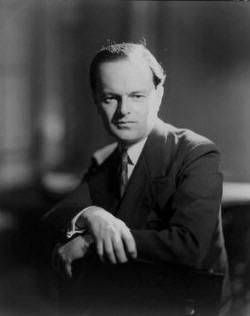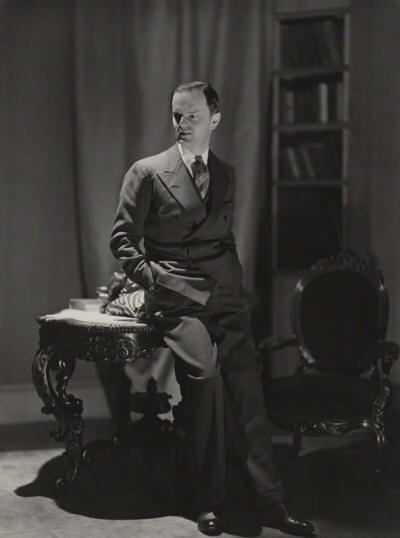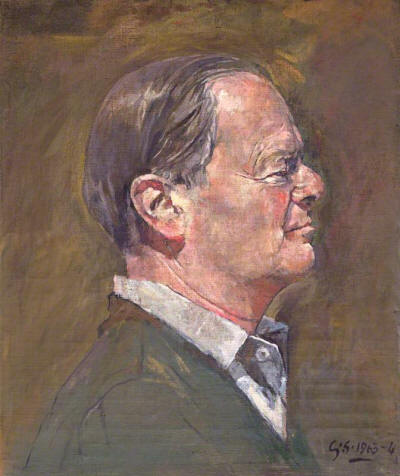 Kenneth Mackenzie Clark, Baron Clark OM CH KCB FBA (13 July 1903 – 21 May 1983) was a British art historian, museum director, and broadcaster.
Kenneth Mackenzie Clark, Baron Clark OM CH KCB FBA (13 July 1903 – 21 May 1983) was a British art historian, museum director, and broadcaster. Queer Places:
30 Portland Pl, Marylebone, London W1B 1LZ, UK
Upper Terrace House, Upper Terrace & Windmill Hill, London NW3 6RL, UK
Saltwood Castle, Castle Rd, Hythe CT21 4QA, UK
University of Oxford, Oxford, Oxfordshire OX1 3PA
St Peter and St Paul Churchyard
Saltwood, Shepway District, Kent, England
 Kenneth Mackenzie Clark, Baron Clark OM CH KCB FBA (13 July 1903 – 21 May 1983) was a British art historian, museum director, and broadcaster.
Kenneth Mackenzie Clark, Baron Clark OM CH KCB FBA (13 July 1903 – 21 May 1983) was a British art historian, museum director, and broadcaster.
Kenneth Clark fondly remembered the company, the food, the laughs and the atmosphere that the objects conjured from his visits to Townshend House, where Charles Ricketts and Charles Shannon loved to be surrounded by what they would have called pretty things… No anxiety about plastic values there: simply delight… There was plenty of talk at Townshend House too, but one enjoyed it against a backdrop of visual delights. The dining table appeared to be one vast slab of lapis lazuli (I suppose it was made of several) at the end of which was a barrage of Madonna lilies. I do not remember the food because by the end of the meal I was always tipsy, having had to swallow half a bottle of Orvieto Secco, and several glasses of revolting Italian liqueur which Ricketts drank because of its name, Strega. No wonder that when Ricketts said, Come and grub with me, one always said, Yes, and put off any other engagement.
In his memoirs, the art historian Kenneth Clark wrote: ‘I made my way to Berlin, where I spent my time in museums and galleries, and so saw nothing of the ferocious depravities which made so great an impression on my friend Eddy Sackville-West, and later on Stephen Spender.’
Clark was born at 32 Grosvenor Square, London,[n 1] the only child of Kenneth Mackenzie Clark (1868–1932) and his wife, (Margaret) Alice, daughter of James McArthur of Manchester.[2] The Clarks were a Scottish family who had grown rich in the textile trade. Clark's great-great-grandfather invented the cotton spool, and the Clark Thread Company of Paisley had grown into a substantial business.[1] Kenneth Clark senior worked briefly as a director of the firm and retired in his mid-twenties as a member of the "idle rich", as Clark junior later put it: although "many people were richer, there can have been few who were idler".[1][3] The Clarks maintained country homes at Sudbourne Hall, Suffolk, and at Ardnamurchan, Argyll, and wintered on the French Riviera.[2][4] Kenneth senior was a sportsman, a gambler,[n 2] an eccentric and a heavy drinker.[2][6] Clark had little in common with his father, though he always remained fond of him. Alice Clark was shy and distant, but her son received affection from a devoted nanny.[7]

Kenneth Clark by Howard Coster, 1934 (© National Portrait Gallery, London).

Kenneth Clark, Baron Clark
Graham Vivian Sutherland (1903–1980)
National Portrait Gallery, London
Clark was educated at Wixenford School and, from 1917 to 1922, Winchester College. The latter was known for its intellectual rigour and – to Clark's dismay – enthusiasm for sports, but it also encouraged its pupils to develop interests in the arts.[12] The headmaster, Montague Rendall, was a devotee of Italian painting and sculpture, and inspired Clark, among many others, to appreciate the works of Giotto, Botticelli, Bellini and their compatriots.[13] The school library contained the collected writings of John Ruskin, which Clark read avidly, and which influenced him for the rest of his life, not only in their artistic judgments but in their progressive political and social beliefs.[14][n 3] From Winchester, Clark won a scholarship to Trinity College, Oxford, where he studied modern history. He graduated in 1925 with a second-class honours degree. In the Oxford Dictionary of National Biography Sir David Piper comments that Clark had been expected to gain a first-class degree, but had not applied himself single-mindedly to his historical studies: "his interests had already turned conclusively to the study of art".[2] While at Oxford, Clark was greatly impressed by the lectures of Roger Fry, the influential art critic who staged the first Post-Impressionism exhibitions in Britain. Under Fry's influence he developed an understanding of modern French painting, particularly the work of Cézanne.[16] Clark attracted the attention of Charles F. Bell (1871–1966), Keeper of the Fine Art Department of the Ashmolean Museum. Bell became a mentor to him and suggested that for his B Litt thesis Clark should write about the Gothic revival in architecture. At that time it was a deeply unfashionable subject; no serious study had been published since the nineteenth century.[17] Although Clark's main area of study was the Renaissance, his admiration for Ruskin, the most prominent defender of the neo-Gothic style, drew him to the topic. He did not complete the thesis, but later turned his researches into his first full-length book, The Gothic Revival (1928).[2] In 1925, Bell introduced Clark to Bernard Berenson, an influential scholar of the Italian Renaissance and consultant to major museums and collectors. Berenson was working on a revision of his book Drawings of the Florentine Painters, and invited Clark to help. The project took two years, overlapping with Clark's studies at Oxford.[18]
After running two important art galleries in the 1930s and 1940s, Clark came to wider public notice on television, presenting a succession of programmes on the arts during the 1950s and 1960s, culminating in the Civilisation series in 1969. The son of rich parents, Clark was introduced to the arts at an early age. Among his early influences were the writings of John Ruskin, which instilled in him the belief that everyone should have access to great art. After coming under the influence of the connoisseur and dealer Bernard Berenson, Clark was appointed director of the Ashmolean Museum in Oxford aged twenty-seven, and three years later he was put in charge of Britain's National Gallery. His twelve years there saw the gallery transformed to make it accessible and inviting to a wider public. During the Second World War, when the collection was moved from London for safe keeping, Clark made the building available for a series of daily concerts given by Myra Hess, which proved a celebrated morale booster during the Blitz. After the war, and three years as Slade Professor of Fine Art at Oxford, Clark surprised many by accepting the chairmanship of the UK's first commercial television network. Once the service had been successfully launched he agreed to write and present programmes about the arts. These established him as a household name in Britain, and he was asked to create the first colour series about the arts, Civilisation, first broadcast in 1969 in Britain and in many other countries soon afterwards. Among many honours, Clark was knighted at the unusually young age of thirty-five, and three decades later was made a life peer shortly before the first transmission of Civilisation. Three decades after his death, Clark was celebrated in an exhibition at Tate Britain in London, prompting a reappraisal of his career by a new generation of critics and historians. Opinions varied about his aesthetic judgment, particularly in attributing paintings to old masters, but his skill as a writer and his enthusiasm for popularising the arts were widely recognised. Both the BBC and the Tate described him in retrospect as one of the most influential figures in British art of the twentieth century.
In 1927 Clark married a fellow student, Elizabeth Winifred Martin, known as "Jane" (1902–1976), the daughter of Robert Macgregor Martin, a Dublin businessman, and Emily Winifred Dickson. The couple had three children: Alan, in 1928, and twins, Colette (known as Celly, pronounced "Kelly") and Colin, in 1932.[2] Away from his official duties, Clark enjoyed what he described as "the Great Clark Boom" in the 1930s. He and his wife lived and entertained in considerable style in a large house in Portland Place. In Piper's words, "the Clarks in joint alliance became stars of London high society, intelligentsia, and fashion, from Mayfair to Windsor".[2] The Clarks' marriage was devoted but stormy. Clark was a womaniser, and although Jane had love affairs, notably with the composer William Walton, she took some of her husband's extramarital relationships badly.[91] She suffered severe mood swings and later alcoholism and a stroke.[92] Clark remained firmly supportive of his wife during her decline.[2] The Clarks' relations with their three children were sometimes difficult, particularly with their elder son, Alan. He was regarded by his father as a fascist by conviction though also as the ablest member of the Clark family "parents included";[93] he became a Conservative member of parliament and junior minister, and a celebrated diarist.[94] The younger son, Colin, became a film-maker, who among other work directed his father in television series in the 1970s.[95] The twin daughter, Colette, became an official and board member of the Royal Opera House; she outlived her parents and brothers, and was the key source for James Stourton's authorised biography of her father, published in 2016.[96] During the war the Clarks lived at Capo Di Monte, a cottage in Hampstead, before moving to the much larger Upper Terrace House nearby.[97] They moved in 1953 when Clark bought the Norman castle of Saltwood in Kent, which became the family home.[98] In his later years he passed the castle to his elder son, moving to a purpose-built house in the grounds.[99] Jane Clark died in 1976. Her death was expected, but left Clark devastated. Several of his female friends hoped that he would marry them. His closest female friend, across many years, was Janet Stone, wife of the engraver Reynolds Stone; in common with Clark's daughter and sons, she was dismayed when he announced his intention to marry Nolwen de Janzé-Rice (1924–1989), daughter of Frederic and Alice de Janzé.[100] The family felt that Clark was acting precipitately in marrying someone he had not known well for very long, but the wedding took place in November 1977.[100] Clark and his second wife remained together until his death.[90]
In 1932, Vanessa Bell and Duncan Grant were commissioned to produce a dinner service for Kenneth Clark. With the active participation of his wife Jane Clark, and much to her husband's surprise, they produced the Famous Women Dinner Service: 50 plates painted with portraits. This work was believed lost until 2017, but had actually survived intact.
My published books: